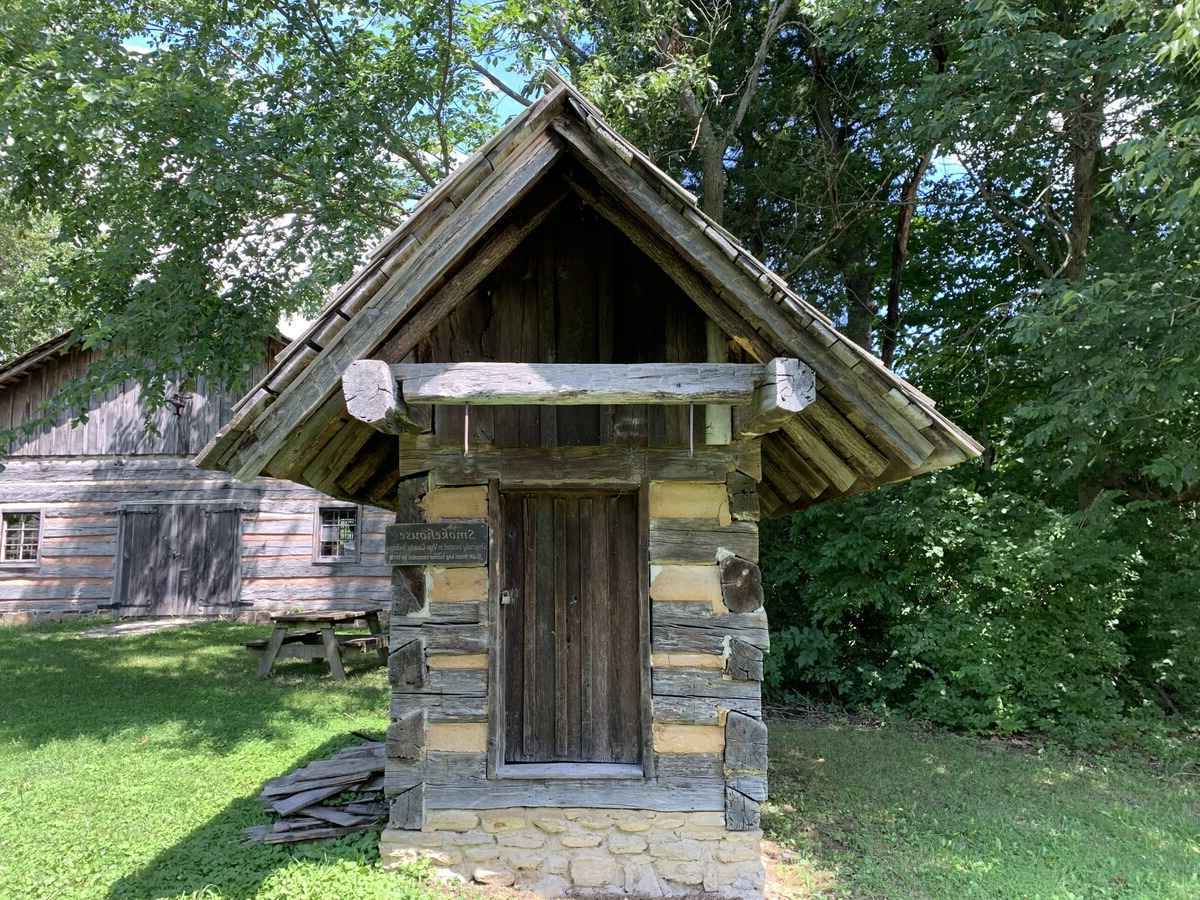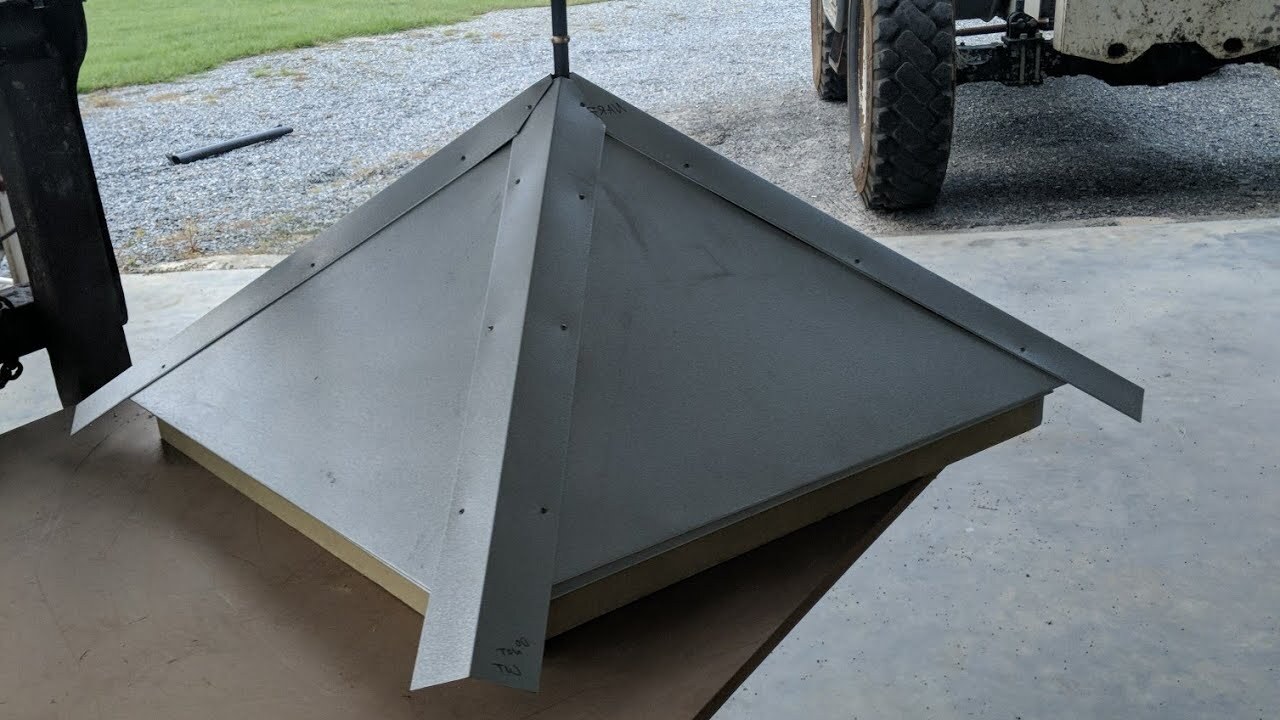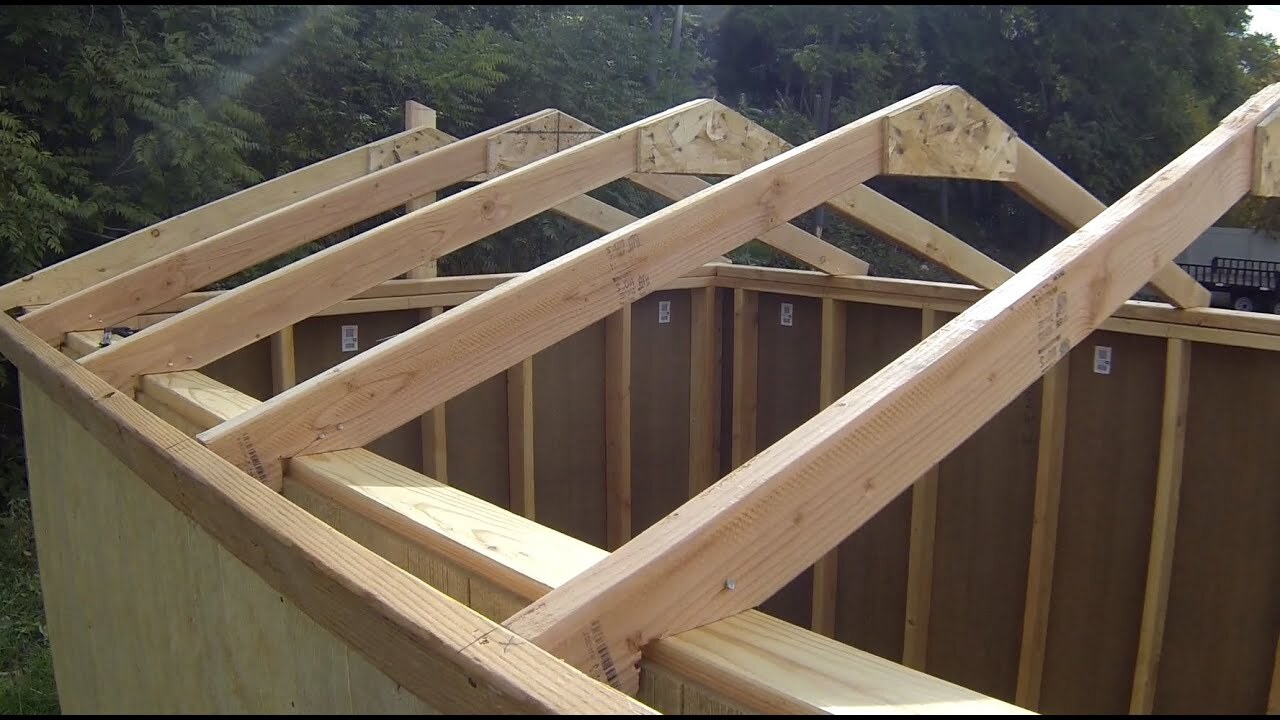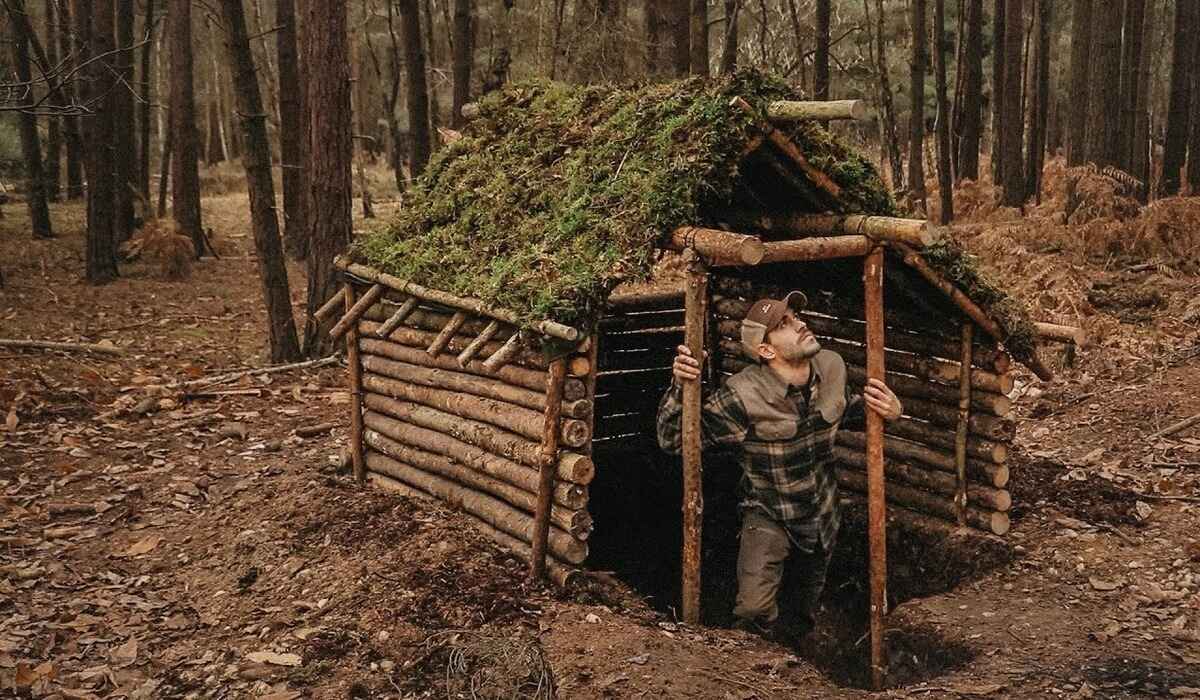Home>Create & Decorate>DIY & Crafts>How To Build A Smokehouse


DIY & Crafts
How To Build A Smokehouse
Published: February 24, 2024

Content Creator specializing in woodworking and interior transformations. Caegan's guides motivate readers to undertake their own projects, while his custom furniture adds a personal touch.
Learn how to build a DIY smokehouse for your backyard with our step-by-step guide. Perfect for smoking meats and other delicious treats. Discover the best tips and tricks for creating your own smokehouse.
(Many of the links in this article redirect to a specific reviewed product. Your purchase of these products through affiliate links helps to generate commission for Twigandthistle.com, at no extra cost. Learn more)
Introduction
Welcome to the world of DIY smokehouses! If you're a fan of savory, smoky flavors and enjoy experimenting with culinary techniques, building your own smokehouse can be a rewarding and fulfilling project. Whether you're a seasoned DIY enthusiast or a novice looking to embark on a new adventure, constructing a smokehouse allows you to infuse your favorite meats, fish, and vegetables with rich, aromatic smokiness right in your backyard.
A smokehouse is a versatile addition to any home, offering the opportunity to elevate your cooking skills and impress your friends and family with delectable smoked delicacies. From traditional smoked brisket and ribs to artisanal cheeses and homemade jerky, the possibilities are endless once you have your own smokehouse at your disposal.
In this comprehensive guide, we will walk you through the step-by-step process of building a smokehouse, from selecting the ideal location to testing the functionality of your finished creation. Whether you're aiming to create a compact smokehouse for your urban patio or a larger structure for your rural property, this guide will equip you with the knowledge and confidence to bring your vision to life.
By following the detailed instructions and tips provided in this guide, you'll gain a deeper understanding of the craftsmanship and ingenuity involved in constructing a functional and efficient smokehouse. Additionally, you'll have the opportunity to customize your smokehouse to suit your specific needs and preferences, ensuring that it becomes a cherished centerpiece of your outdoor cooking endeavors.
So, roll up your sleeves, gather your tools and materials, and get ready to embark on an exciting journey into the art of smokehouse construction. Whether you're a barbecue aficionado, a culinary enthusiast, or simply someone who appreciates the satisfaction of creating something with your own hands, building a smokehouse is a gratifying endeavor that promises to enrich your culinary experiences for years to come. Let's dive in and start building your very own smokehouse!
Read more: How To Build A Hearth
Step 1: Selecting the Location
The first and arguably most crucial step in building a smokehouse is selecting the ideal location for your project. The location will not only determine the functionality and efficiency of your smokehouse but also contribute to the overall aesthetic appeal of your outdoor space. Here are some key considerations to keep in mind as you embark on this pivotal step:
1.1 Assessing Space and Accessibility
Begin by surveying your outdoor area to identify a suitable spot for the smokehouse. Consider the available space and ensure that the chosen location provides ample room for the size of smokehouse you intend to build. Accessibility is also paramount, as you'll want to ensure that the location allows for easy transportation of materials and equipment during the construction process.
1.2 Proximity to Utilities
If you plan to incorporate electricity or water into your smokehouse design, proximity to utilities such as power outlets and water sources should be taken into account. This will streamline the installation process and ensure that your smokehouse is equipped with essential amenities for optimal functionality.
1.3 Ventilation and Airflow
Effective ventilation is essential for a well-functioning smokehouse. Look for a location that allows for proper airflow to facilitate the smoke curing process. Additionally, consider prevailing wind patterns to prevent smoke from accumulating in undesired areas of your outdoor space.
Read more: How To Build A Wardrobe
1.4 Protection from Elements
While a smokehouse is designed to withstand outdoor conditions, it's beneficial to choose a location that offers some protection from the elements. This can include natural barriers such as trees or structures that provide shelter from strong winds and excessive exposure to sunlight or rain.
1.5 Aesthetic Integration
Beyond its practical considerations, the location of your smokehouse should harmonize with the overall aesthetic of your outdoor space. Whether you envision a rustic, countryside charm or a sleek, modern design, the location should complement the visual appeal of your property while adding a touch of character and functionality.
By carefully evaluating these factors, you can confidently select a location that sets the stage for the successful construction and long-term enjoyment of your custom-built smokehouse. With the location secured, you're ready to move on to the next exciting phase of gathering materials and tools for your project.
Step 2: Gathering Materials and Tools
The successful construction of a smokehouse hinges on the availability of the right materials and tools. By assembling a comprehensive inventory of essential items, you can streamline the building process and ensure that you have everything you need at your fingertips. Here's a detailed breakdown of the materials and tools required to embark on this exciting DIY endeavor:
2.1 Materials
2.1.1 Lumber
Select high-quality, weather-resistant lumber for the frame and walls of the smokehouse. Pressure-treated wood or cedar are popular choices due to their durability and ability to withstand outdoor conditions.
2.1.2 Exterior Grade Plywood
For the construction of walls and roofing, exterior grade plywood is an excellent option. Ensure that the plywood is designed to withstand moisture and temperature variations.
2.1.3 Metal Brackets and Fasteners
Invest in sturdy metal brackets and fasteners to reinforce the structural integrity of the smokehouse. These components play a crucial role in securing the frame and walls together.
2.1.4 Insulation Materials
If you plan to use your smokehouse year-round, consider incorporating insulation materials to regulate internal temperatures. Fiberglass insulation or foam board insulation can help maintain a consistent smoking environment.
2.1.5 Weatherproofing Sealant
To protect the exterior surfaces of the smokehouse from moisture and environmental damage, acquire a high-quality weatherproofing sealant. This will prolong the lifespan of the structure and safeguard it against the elements.
2.1.6 Metal Roofing Sheets
For the roof of the smokehouse, metal roofing sheets provide durable protection against rain and snow. Choose a corrosion-resistant option to ensure long-term functionality.
Read more: How To Build A Dock
2.2 Tools
2.2.1 Circular Saw
A reliable circular saw is essential for cutting lumber and plywood to the required dimensions. Opt for a saw with adjustable cutting angles for precision.
2.2.2 Power Drill
A power drill equipped with a variety of drill bits will be indispensable for assembling the smokehouse frame, installing brackets, and creating ventilation openings.
2.2.3 Hammer and Nails
Traditional yet indispensable, a sturdy hammer and a selection of nails are fundamental for securing wooden components and fastening materials together.
2.2.4 Level and Measuring Tape
Accurate measurements and level surfaces are crucial for the structural integrity of the smokehouse. A reliable level and measuring tape will aid in achieving precision during construction.
2.2.5 Safety Gear
Prioritize safety by equipping yourself with protective gear, including gloves, safety goggles, and a dust mask. These items are essential for safeguarding against potential hazards during construction.
By procuring these materials and tools, you'll be well-prepared to commence the construction of your smokehouse with confidence and efficiency. With the groundwork laid and the necessary resources at your disposal, you're poised to embark on the next phase of building the frame for your custom smokehouse.
Step 3: Building the Frame
The construction of the frame forms the structural backbone of your smokehouse, providing stability and support for the subsequent installation of walls, roofing, and essential components. Building a sturdy and well-aligned frame is crucial for ensuring the overall integrity and functionality of your smokehouse. Here's a detailed breakdown of the steps involved in constructing the frame:
3.1 Laying the Foundation
Begin by preparing the foundation for the frame. Depending on your preference and the size of the smokehouse, you can opt for a concrete base or a robust wooden platform. Ensure that the foundation is level and capable of supporting the weight of the frame and the entire structure.
3.2 Assembling the Base Frame
Using the lumber and metal brackets, assemble the base frame of the smokehouse according to your predetermined dimensions. Utilize a level to ensure that the frame is perfectly horizontal and square, as this will serve as the foundation for the rest of the structure.
Read more: How To Build A Sauna
3.3 Erecting Vertical Supports
With the base frame in place, erect the vertical supports at designated intervals along the perimeter of the base. These supports will determine the height and shape of the smokehouse, so precision in their placement is essential. Secure the vertical supports firmly to the base frame using appropriate fasteners.
3.4 Installing Cross Braces
To reinforce the stability of the frame, install cross braces between the vertical supports. These braces will prevent swaying and shifting, especially in areas prone to strong winds or seismic activity. Ensure that the cross braces are securely fastened and add structural integrity to the frame.
3.5 Verifying Alignment and Stability
Once the frame is fully assembled, carefully verify the alignment and stability of the structure. Use a level to confirm that the frame is plumb and square, making any necessary adjustments to ensure uniformity and structural integrity.
3.6 Incorporating Door and Vent Openings
During the frame construction, consider incorporating openings for doors and vents as per your design specifications. These openings will facilitate access to the smokehouse and promote proper airflow for the smoking process.
By meticulously following these steps, you can successfully build a robust and well-structured frame for your smokehouse. With the frame in place, you're ready to progress to the next phase of installing the smokehouse walls, bringing you one step closer to the realization of your custom-built smokehouse.
Read more: How To Build An Ark
Step 4: Installing the Smokehouse Walls
With the frame of the smokehouse securely in place, the next critical step is the installation of the walls, which will enclose the structure and create a controlled environment for the smoking process. The walls not only contribute to the overall stability and durability of the smokehouse but also play a pivotal role in maintaining the desired temperature and smoke circulation. Here's a detailed guide on the process of installing the smokehouse walls:
4.1 Selecting and Preparing Wall Materials
Before commencing the installation, carefully select the appropriate materials for the walls. Exterior grade plywood is a popular choice due to its resilience against outdoor elements. Cut the plywood panels to the precise dimensions required for each section of the smokehouse, ensuring accuracy and a snug fit.
4.2 Attaching the Wall Panels
Begin by affixing the prepared plywood panels to the exterior of the frame, starting from the base and working upwards. Use a power drill and suitable fasteners to securely attach the panels to the frame, ensuring that they are aligned and flush with the edges of the frame. Pay close attention to the corners and joints, ensuring a seamless connection between the panels.
4.3 Sealing and Weatherproofing
Once the wall panels are in place, apply a high-quality weatherproofing sealant to the exterior surfaces of the plywood. This sealant serves as a protective barrier against moisture, UV exposure, and temperature fluctuations, safeguarding the walls from deterioration and ensuring long-term durability.
Read more: How To Build A Trebuchet
4.4 Creating Ventilation Openings
Incorporate ventilation openings into the walls to facilitate the circulation of smoke and air within the smokehouse. These openings can be strategically positioned to align with the smoke generator and promote efficient smoke distribution throughout the interior. Use a circular saw to create precise openings, and install adjustable vents to regulate airflow as needed.
4.5 Insulation (Optional)
If you intend to use the smokehouse in varying weather conditions, consider adding insulation material between the wall panels to regulate internal temperatures. This step is particularly beneficial for maintaining consistent smoking conditions and enhancing energy efficiency.
By meticulously following these steps, you can effectively install the walls of your smokehouse, bringing you closer to the realization of a fully enclosed and functional smoking environment. With the walls in place, the focus shifts to constructing the roof, a pivotal component that provides protection and further enhances the structural integrity of your custom-built smokehouse.
Step 5: Constructing the Roof
The construction of the roof marks a significant milestone in the creation of your custom smokehouse, as it not only provides essential protection from the elements but also contributes to the overall aesthetic appeal of the structure. Building a durable and weather-resistant roof is crucial for ensuring the longevity and functionality of your smokehouse. Here's a detailed guide on the process of constructing the roof:
5.1 Selecting Roofing Materials
Begin by selecting suitable roofing materials that offer durability and weather resistance. Metal roofing sheets are a popular choice due to their ability to withstand moisture, UV exposure, and temperature fluctuations. Opt for corrosion-resistant materials to ensure long-term performance and minimal maintenance requirements.
Read more: How To Build Rafters
5.2 Measuring and Cutting
Accurately measure the dimensions of the roof area to determine the precise size of the roofing sheets required. Using a circular saw, carefully cut the metal roofing sheets to fit the dimensions of the roof structure. Precision in cutting is essential to ensure a seamless and watertight fit for the roofing materials.
5.3 Securing the Roofing Sheets
Once the roofing sheets are cut to size, securely fasten them to the roof frame using appropriate fasteners. Ensure that the sheets are aligned and overlap correctly to prevent water infiltration. Pay attention to the edges and corners, applying sealant as needed to reinforce the weatherproofing of the roof.
5.4 Adding Eaves and Overhangs
Consider incorporating eaves and overhangs into the roof design to provide additional protection from rain and direct sunlight. These features not only enhance the functionality of the smokehouse but also contribute to its visual appeal, adding a touch of architectural character to the structure.
5.5 Installing Gutters and Drainage
To manage rainwater runoff effectively, install gutters along the edges of the roof and connect them to a suitable drainage system. Proper drainage prevents water accumulation around the smokehouse, safeguarding the foundation and surrounding landscape from potential water damage.
Read more: How To Build A Pantry
5.6 Verifying Structural Integrity
Upon completing the installation of the roof, carefully inspect the structure to verify its structural integrity and weatherproofing. Ensure that the roofing materials are securely fastened, and there are no gaps or vulnerabilities that could compromise the protective function of the roof.
By following these detailed steps, you can successfully construct a robust and weather-resistant roof for your smokehouse, bringing you one step closer to the realization of a fully functional and visually appealing outdoor smoking environment. With the roof in place, the focus shifts to the integration of the smoke generator, a pivotal component that brings the smokehouse to life.
Step 6: Adding the Smoke Generator
The integration of a reliable smoke generator is a pivotal step in transforming your custom-built smokehouse into a fully functional and efficient smoking environment. The smoke generator serves as the heart of the smoking process, infusing your culinary creations with rich, aromatic flavors and ensuring consistent smoke circulation within the smokehouse. Here's a comprehensive guide on the process of adding the smoke generator to your smokehouse:
6.1 Selecting a Suitable Smoke Generator
Begin by selecting a smoke generator that aligns with the size and smoking capacity of your smokehouse. Whether you opt for a traditional wood chip smoker, an electric smoker, or a pellet smoker, consider factors such as fuel efficiency, ease of operation, and the ability to regulate smoke intensity. Additionally, ensure that the smoke generator is designed for outdoor use and capable of withstanding varying weather conditions.
6.2 Positioning the Smoke Generator
Strategically position the smoke generator outside the smokehouse, ensuring that it is located in close proximity to the ventilation openings. This placement allows for efficient smoke distribution into the smokehouse while preventing the accumulation of excessive heat or smoke within the structure. Consider installing a dedicated smoke duct to channel the smoke from the generator into the smokehouse, promoting uniform smoke circulation.
Read more: How To Build A Battlebot
6.3 Establishing Power or Fuel Connection
If you opt for an electric or pellet smoker, establish a reliable power source to supply the necessary energy for the smoke generator. Ensure that the power connection is weatherproof and safely routed to prevent potential hazards. For wood chip smokers, prepare the fuel chamber and ventilation system to facilitate the controlled combustion of wood chips, creating the desired smoke for the smoking process.
6.4 Testing and Calibration
Before initiating the smoking process, conduct a thorough test and calibration of the smoke generator to ensure optimal functionality. Verify that the smoke output is consistent and adjustable, allowing you to fine-tune the intensity of the smoke as needed. This step is crucial for achieving precise control over the smoking environment and ensuring the quality of the smoked products.
6.5 Integration with Ventilation System
Integrate the smoke generator with the ventilation system of the smokehouse, ensuring that the smoke is effectively circulated throughout the interior. Adjust the positioning and aperture of the ventilation openings to align with the smoke generator, promoting efficient airflow and smoke distribution. This integration is essential for maintaining a balanced smoking environment and achieving desirable smoking outcomes.
By meticulously following these steps, you can seamlessly integrate a reliable smoke generator into your custom smokehouse, unlocking the potential to create a diverse array of smoked delicacies with precision and control. With the smoke generator in place, your smokehouse is poised to become a hub of culinary creativity and a source of delectable, smoky flavors for years to come.
Step 7: Testing the Smokehouse
With the construction of your custom smokehouse nearing completion, the crucial step of testing the functionality and performance of the smokehouse awaits. Testing the smokehouse not only ensures that all components are operating as intended but also provides valuable insights into the smoking environment's consistency and efficiency. Here's a detailed guide on the process of testing your newly built smokehouse:
Read more: How To Build A Trailer
7.1 Preparing the Smokehouse Interior
Before initiating the testing phase, thoroughly clean the interior of the smokehouse to remove any debris or construction residues. Ensure that the ventilation openings are unobstructed and that the smoke generator is positioned and operational. Verify that the temperature and humidity levels within the smokehouse are conducive to the smoking process, making any necessary adjustments to achieve the desired conditions.
7.2 Trial Run with Wood Chips or Pellets
If you've opted for a wood chip or pellet smoker, conduct a trial run using the chosen smoking fuel. Load the smoke generator with the appropriate amount of wood chips or pellets and initiate the smoking process. Observe the smoke distribution within the smokehouse, paying attention to the consistency and intensity of the smoke. This trial run allows you to assess the functionality of the smoke generator and make adjustments to achieve optimal smoke production.
7.3 Temperature and Airflow Monitoring
Throughout the testing phase, monitor the internal temperature of the smokehouse using a reliable thermometer. Ensure that the temperature remains within the ideal range for the specific smoking requirements of your culinary creations. Simultaneously, observe the airflow and smoke circulation within the smokehouse, confirming that the ventilation system effectively distributes the smoke while maintaining a balanced environment.
7.4 Assessing Smoke Distribution and Uniformity
Observe the distribution of smoke within the smokehouse, paying attention to any areas of uneven smoke coverage. Verify that the smoke reaches all sections of the smokehouse, ensuring that the smoking process uniformly infuses the desired flavors into the culinary items. Make adjustments to the positioning of the smoke generator or ventilation openings as needed to achieve consistent smoke distribution.
Read more: How To Build A Clubhouse
7.5 Quality Assurance with Test Products
As a final step, conduct a small-scale smoking trial using test products such as a sample of meat, fish, or vegetables. Place the test products within the smokehouse and monitor the smoking process, assessing the resulting flavors and aromas. This test allows you to verify the quality and consistency of the smoking outcomes, providing valuable feedback on the functionality of the smokehouse.
By meticulously conducting these testing procedures, you can ensure that your custom smokehouse meets the standards of functionality, performance, and consistency. The testing phase serves as a pivotal validation of your construction efforts, affirming the successful creation of a versatile and efficient smoking environment. With the smokehouse tested and validated, you're ready to embark on a journey of culinary exploration and creativity, leveraging the capabilities of your custom-built smokehouse to craft an array of tantalizing smoked delicacies.
Conclusion
Congratulations on successfully completing the construction of your custom smokehouse! The journey from selecting the ideal location to testing the functionality of the smokehouse has been a testament to your dedication and craftsmanship. As you stand before the culmination of your efforts, it's essential to reflect on the significance of this achievement and the boundless potential that your newly built smokehouse holds.
Your smokehouse represents more than a mere structure; it embodies a gateway to a world of culinary creativity and sensory exploration. With its sturdy frame, weather-resistant walls, and durable roof, your smokehouse stands as a testament to your commitment to quality and functionality. The integration of a reliable smoke generator further elevates the capabilities of the smokehouse, offering precise control over the smoking environment and the potential to craft an array of delectable smoked delicacies.
As you venture into the realm of smokehouse culinary arts, your custom-built smokehouse becomes a canvas for experimentation and innovation. From infusing tender cuts of meat with rich, smoky flavors to crafting artisanal smoked cheeses and vegetables, the possibilities are as vast as your imagination. The testing phase has validated the efficiency and consistency of your smokehouse, paving the way for a journey of culinary exploration and the creation of signature smoked dishes that captivate the senses.
Beyond its practical functionality, your smokehouse embodies the spirit of craftsmanship and ingenuity. It stands as a testament to your ability to transform raw materials into a functional and aesthetically pleasing structure that enriches your outdoor space. The process of building a smokehouse has not only honed your DIY skills but has also instilled a sense of pride and accomplishment, underscoring the value of hands-on creation and the fulfillment derived from bringing a vision to fruition.
As you embark on this new chapter of culinary exploration with your custom smokehouse, remember that it is more than a mere cooking apparatus; it is a symbol of creativity, perseverance, and the joy of savoring the fruits of your labor. Embrace the opportunities that your smokehouse presents, share the flavors of your creations with friends and family, and revel in the satisfaction of knowing that you have crafted a space where culinary artistry and sensory delight converge.
With your custom smokehouse as a steadfast companion in your culinary endeavors, may each smoking session be a celebration of creativity, flavor, and the joy of bringing exceptional smoked dishes to life. Embrace the art of smoking with passion and curiosity, and let your custom-built smokehouse be the stage for countless memorable culinary experiences.
The journey of building your smokehouse may have reached its conclusion, but the adventure of culinary exploration that awaits has only just begun. Cheers to your custom smokehouse and the flavorful adventures that lie ahead!






